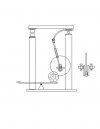I agree with kindyr, there should be some sort of tuning ability for the arm. Low frequency harmonics are a powerful force at 6 cycles/second. Besides the need for bracing, make sure the rear post is beefy. A lot of force may transfer to it. The motor can be suspended on a hinged plate so it hangs just clear of the tire. The foot pedal can pull/push it against the wheel. Some sort of cam is all that the end of the foot control arm needs. A skate board wheel, or similar wheel, would work fine for the cam roller ( to reduce the friction and make control very smooth). I can draw this up for you if you need to see what I am talking about.
Several of the plans for tire hammers use a leaf spring for the helve. This gives both flexible strength and deals with the vibrations.
As far as being able to be picked up by one person......I don't know about that. There will need to be a certain amount of mass to the base as well as the unit itself. I would think that at a minimum ,it will end up weighing nearly 200 pounds. Some sort of sturdy wooden base will be needed to bolt it to as well. Also, the drive tire needs some mass to act as a flywheel. If the motor is 1750RPM, the 400BPM drive ratio for the motor-tire is about 4.5:1, so a 16" diameter tire will need to be driven by a 3.5" wheel on the motor shaft.
By keeping the hammer so small ( 2-4#) you may be able to get around some of these problems, but the unit will be pretty low power. Remember,the resulting power of a hammer blow is a function of the weight of the hammer and the distance it travels. A hand blow that drops 12-18" with a 3# hammer delivers 36-54 inch pounds of energy. A 3# hammer that rises and falls 4" delivers 12 inch pound. That is basically what power planishing hammers do. For doing decorative work on 18-20 gauge sheet metal this hammer will be great. For drawing out 1/2" steel, I don't think so.
I know you have seen them before, but take a look at the Rusty/Dusty plans and consider using some of those ideas in your light weight hammer build....or building a Dusty.
Final comment ( directed to all who are reading this as well as Sam):
In a power hammer mass is a lot of what makes it work. We all would like a 100 pound tool that does the work of a 1000 pound tool, but physics gets in the way of those plans. If anyone is considering building a home made power hammer, there are a lot of technical things you have to cover. When you start getting to 400BPM,things don't work as simple as a water driven 500 pound helve hammer delivering
2-3 BPM ( and weighing many tons).
Also, when things come apart ( and with power hammers they do) all that energy is transfered to the flying arms, bolts, and springs on a power hammer. It can easily be a lethal blow received from a mishaps while building and operating a power hammer.
FWIW, I don't think this project will do much at less than 10# hammer weight.

